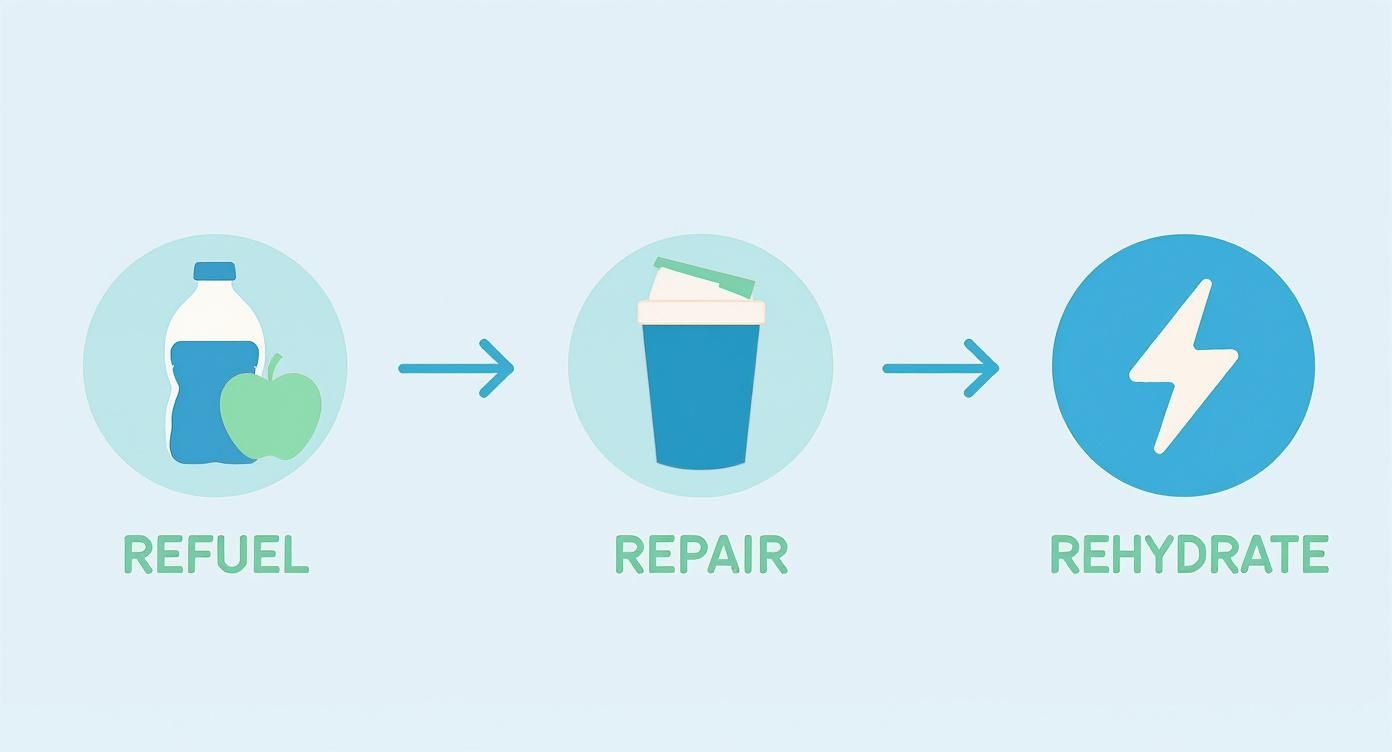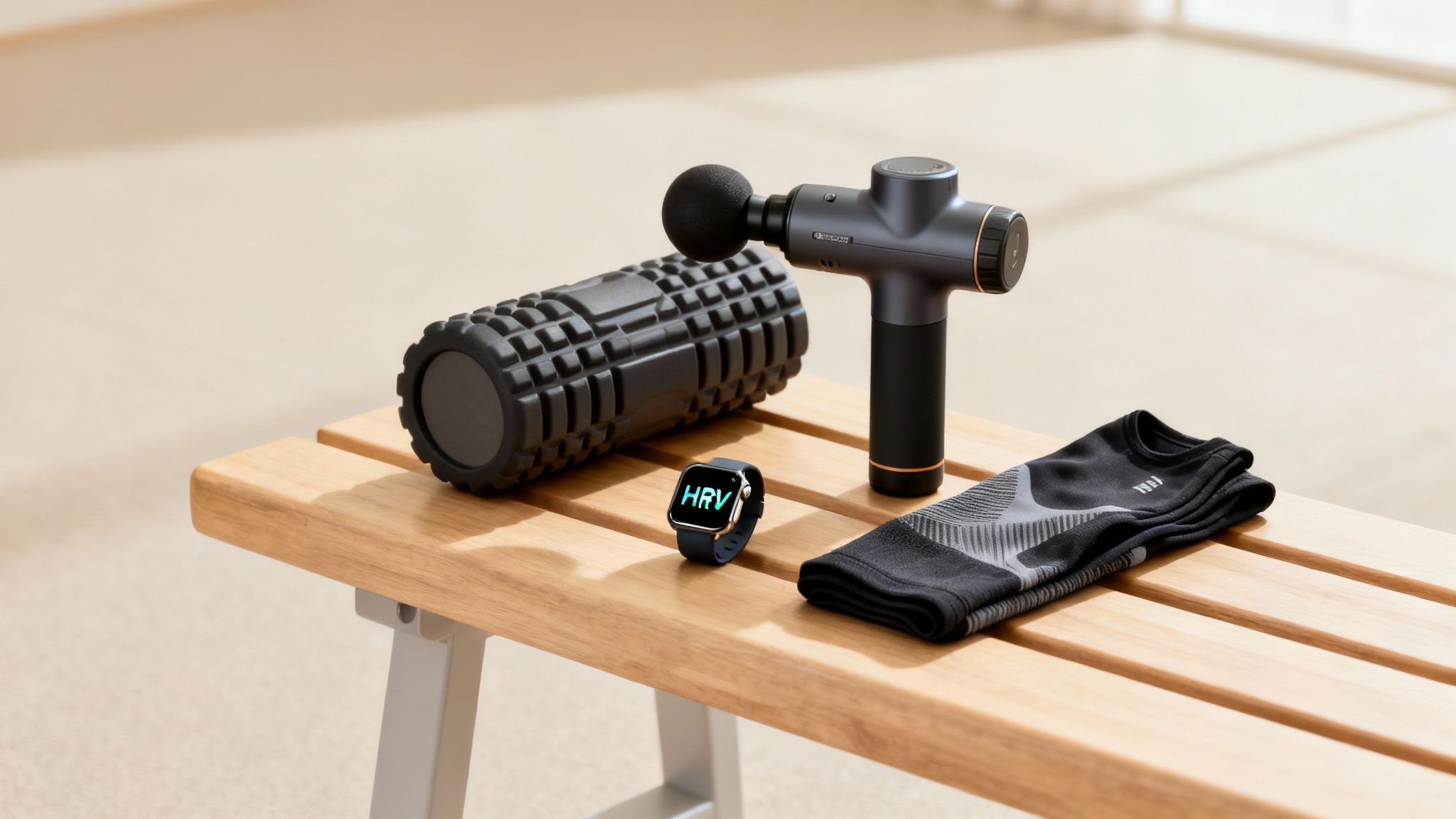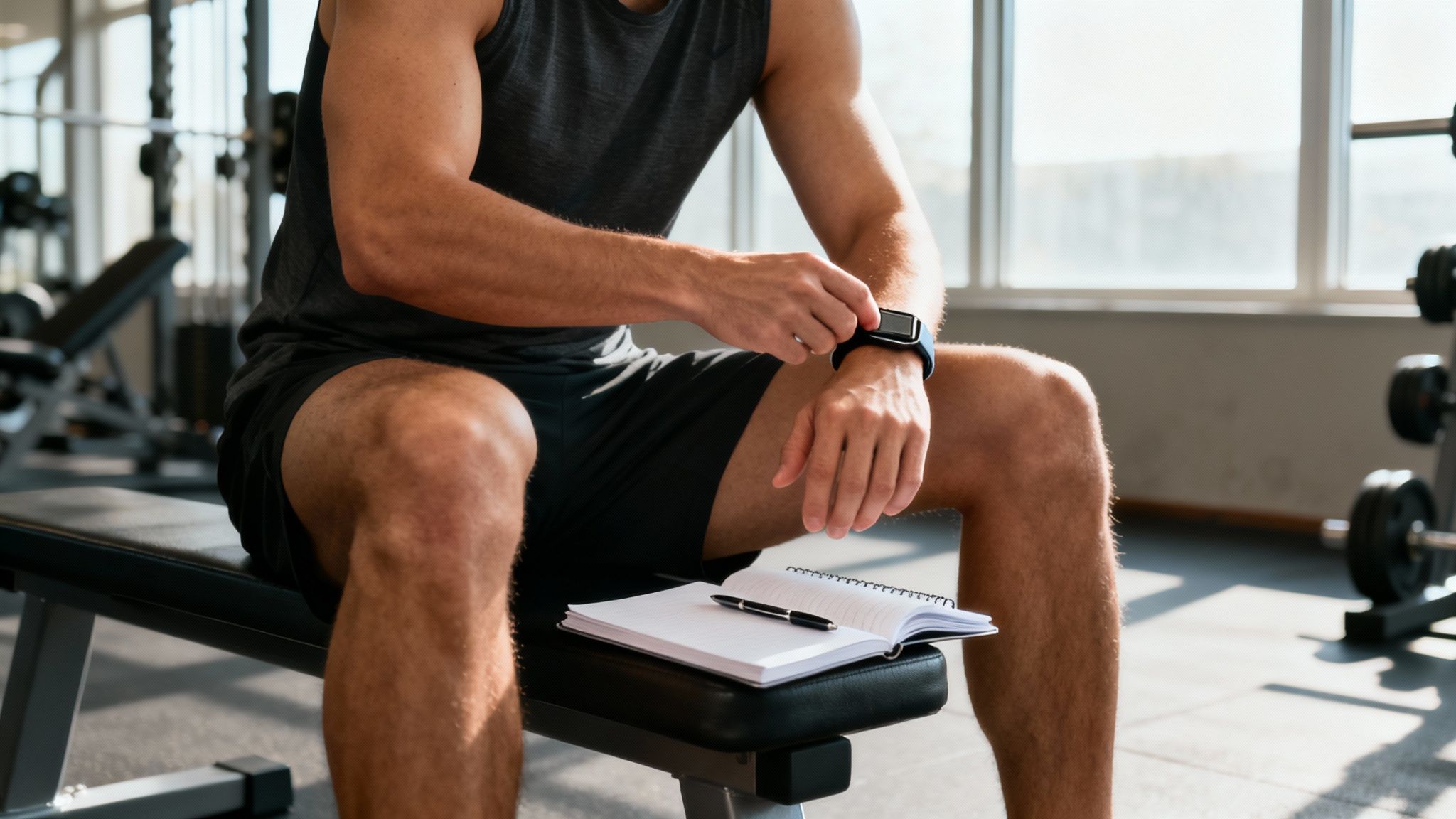Tu carrito está vacío
TIEMPO LIMITADO: Envío GRATIS en todos los pedidos en los 48 estados contiguos
To get the most out of your training, what you do in the minutes and hours after your last rep is just as important as the work itself. That first hour is often called the "golden hour" for a reason.
Nailing this immediate recovery window comes down to a simple, three-part strategy: refuel with carbs, repair with protein, and rehydrate with water and electrolytes. Get these right, and you'll slash your downtime and come back stronger for your next session.
That first 60-90 minutes after you finish training is a critical window. Your body is primed for recovery, and the actions you take here set the stage for how quickly you bounce back. This isn't just about chugging a generic protein shake; it's a strategic approach to kickstart the repair process and make sure all your hard work pays off.
The second you stop moving, your muscles are screaming for fuel. During any intense workout, your body burns through its stored glucose, called glycogen. The main goal now is to restock those depleted energy stores as fast as possible.
This is where fast-digesting carbohydrates are your best friend. Consuming them spikes insulin, which acts like a key, unlocking your muscle cells to shuttle glucose from your bloodstream back into storage. If you drag your feet on this, you're just slowing down the entire recovery timeline.
Training, by its very nature, creates microscopic tears in your muscle fibers. Don't worry, this is a good thing—it’s the signal that tells your body to rebuild bigger and stronger. But to do that, it needs the right building materials, and it needs them now.
That's where protein comes in. The amino acids in protein are the literal building blocks for this reconstruction. Getting a quality protein source in after your workout jump-starts muscle protein synthesis (MPS), the physiological process of repairing and reinforcing that damaged muscle tissue. While the old-school idea of a strict 30-minute "anabolic window" has been debated, the science is clear: timely protein intake absolutely accelerates recovery.
This simple flow chart breaks down the essentials for kickstarting recovery the moment your workout ends.

As you can see, the three pillars are simple: refuel, repair, and rehydrate. Everything else builds on this foundation.
To put this all together, here's a quick-reference checklist you can use to make sure you're hitting all the critical points in that immediate post-workout window.
| Action | Why It's Critical | Strength Athlete Example | Endurance Athlete Example |
|---|---|---|---|
| Consume Protein | Initiates muscle protein synthesis (MPS) to repair muscle fibers. | 25-40g of whey or casein protein in a shake. | 20-30g of whey isolate mixed with water for fast absorption. |
| Consume Carbs | Rapidly replenishes depleted muscle glycogen stores. | 50-70g from a mix of fruit (banana) and a carb powder. | 60-90g from a sports drink, gels, or white rice. |
| Rehydrate | Replaces fluid lost through sweat to support all metabolic functions. | Drink 16-24 oz of fluid for every pound of body weight lost. | Drink 20-24 oz of fluid for every pound lost, aiming for consistent sips. |
| Replenish Electrolytes | Restores minerals essential for muscle function and hydration. | An electrolyte mix with sodium and potassium added to water. | A dedicated electrolyte drink with 300-500mg of sodium. |
This checklist isn't about perfection, but consistency. Hitting these targets consistently will make a massive difference in your performance and how you feel day-to-day.
When you sweat, you lose a lot more than just water. You're also losing critical minerals called electrolytes—like sodium, potassium, and magnesium—that are non-negotiable for nerve function, muscle contractions, and maintaining fluid balance. Even a slight dip in hydration can bring your recovery to a screeching halt.
Here's the thing a lot of people miss: just chugging plain water isn't always enough, especially after a long, grueling session or a workout in the heat. Without electrolytes, your body can't actually hold onto the water you're drinking.
This is why replenishing those lost minerals is just as crucial as replacing the fluid. A good electrolyte powder or drink can be a game-changer. But not all formulas are created equal, so it pays to do your homework. You can check out an electrolyte powder comparison to see how different products stack up on key ingredients. Restoring this delicate mineral balance allows your body to function properly, manage inflammation, and get to work on repairing tissue.
The work you put in at the gym is just the stimulus. The real magic—the adaptation, the growth, the getting stronger—happens in the hours and days that follow. Long after you’ve chugged your post-workout shake, your body is deep in the process of repair and regeneration. Two of the most powerful, yet criminally overlooked, drivers of this process are quality sleep and smart active recovery.
If you get these two things right, it will fundamentally change how you feel and perform.
Think of an intense training session as digging a hole. Your immediate post-workout nutrition starts to fill it back in, but sleep is what paves it over, making the ground stronger than it was before. It's during those deep sleep cycles that your body finally gets down to the serious business of healing.

This is when your endocrine system really kicks into high gear. Your pituitary gland releases a massive surge of Human Growth Hormone (HGH), a non-negotiable player in repairing muscle tissue and promoting new growth. At the same time, the stress hormone cortisol takes a nosedive, creating the perfect hormonal environment for your body to rebuild without interference.
Getting more sleep isn't just about logging more hours in bed; it's about the quality of those hours. A night of tossing and turning won't give you the same restorative punch as deep, uninterrupted slumber. To truly recover faster after your workout, you need to treat your sleep with the same respect you give your training.
Here are a few science-backed ways to turn your sleep into a high-performance tool:
If you do nothing else, focus on making your bedroom a cool, dark cave. It's one of the most effective changes you can make for recovery, as it directly supports the deep sleep stages where the majority of HGH release and physical repair happens.
Hormonal balance is absolutely central to this process. For guys looking to give their body's natural repair cycles a little extra support, understanding how supplements fit into the picture is crucial. For a deeper look, our guide on the optimal usage of HGH supplements for men offers some valuable context on supporting these critical recovery pathways.
The day after a brutal leg session, collapsing on the couch might feel like the only move. And while complete rest has its place, often the smarter strategy is something we call active recovery. This just means performing some low-intensity movement to get blood flowing without piling on any new stress.
Sitting completely still for hours can actually lead to more stiffness and fluid pooling in the muscles, making soreness stick around longer. Gentle movement, on the other hand, acts like a pump. It boosts circulation, helping deliver fresh, oxygen-rich blood to your tired muscles while flushing out all the metabolic junk associated with muscle damage.
The goal here isn't to burn calories or build more muscle; it's purely to speed up the healing process.
The key is to keep the intensity genuinely low. Your heart rate should stay steady, and you should be able to hold a conversation without any trouble. If you’re sweating or getting out of breath, you’re pushing too hard and defeating the purpose.
Here are a few simple and effective active recovery options you can weave into your routine:
When you pair deep, high-quality sleep with intentional, low-intensity movement, you create a powerful 24/7 recovery system. This two-pronged attack ensures your body doesn't just patch up the damage from your last workout—it comes back stronger, more resilient, and ready for whatever you throw at it next.
Beyond the fundamentals of nutrition and sleep, a new wave of recovery technology can give you a serious edge in your training. Let's be honest, some gadgets are more hype than help. But when used strategically, the right tech can dramatically speed up how fast you recover after a workout. It’s all about working smarter, and these tools give you real-time feedback on exactly what your body needs.
This isn't some niche trend anymore; it's becoming standard practice. From wearables to at-home recovery equipment, technology is changing the game. Market data shows searches for 'fitness recovery equipment' hit a peak normalized value of 92 in June 2025. The demand is real.
Modern fitness trackers have come a long way from just counting steps. Today's wearables offer a direct window into your nervous system's readiness, and one metric stands above the rest: Heart Rate Variability (HRV).
HRV is simply the measure of the tiny variations in time between your heartbeats. Generally, a higher HRV means your body is well-rested and ready to take on stress (like a monster leg day). A lower HRV, on the other hand, is a clear sign that you're fatigued and need to back off. Instead of just guessing how you feel, HRV gives you objective data to guide your training intensity for the day.
This graph gives you a visual of how HRV is calculated by measuring the R-R intervals between each heartbeat.

The big takeaway here is that more variability is a good thing. It points to a flexible and resilient autonomic nervous system.
When you see your HRV score trending down for a few days in a row, listen to your body. That’s a clear signal to ease up. Maybe swap that high-intensity interval session for an active recovery day or make sure you get an extra hour of sleep. This kind of proactive approach is how you sidestep overtraining before it even starts.
You don’t need a personal masseuse on call to work out muscle knots and tightness. Tools like foam rollers and massage guns let you perform self-myofascial release, a technique that targets the fascia—the web of connective tissue that wraps around your muscles.
Think of your fascia as the plastic wrap around a cut of meat. When it gets tight, bunched up, and "stuck," it can restrict your movement and cause pain. Applying pressure with these tools helps break up those adhesions, restoring smooth movement and cranking up blood flow to the area.
For endurance athletes, focusing this work on the legs and hips can be a complete game-changer. Our dedicated guide for triathlons and marathons dives into specific protocols you can integrate with these tools.
Two classic recovery methods, contrast therapy and compression, have been staples for elite athletes for decades. Why? Because they flat-out work. Both techniques manipulate your circulatory system to flush out metabolic waste and knock down inflammation.
Contrast Water Therapy
This is as simple as alternating between hot and cold water. The rapid temperature change creates a powerful "pump" effect in your blood vessels:
This cycle is incredibly effective at flushing out inflammatory byproducts and delivering a fresh wave of oxygen to your tired muscles, which can seriously reduce soreness. A classic protocol is 1-2 minutes in cold water, followed by 1-2 minutes in hot, repeated 3-5 times.
Compression Gear
Throwing on a pair of compression socks, tights, or sleeves applies gentle, graduated pressure to your limbs. This external pressure helps stop fluid from pooling in your muscles and gives your veins a helping hand in pushing deoxygenated blood back toward your heart. It’s a simple, passive way to boost circulation and cut down on swelling, especially after a long run or a heavy lifting session.
Navigating the supplement world can feel like a full-time job. But you don't need a cabinet full of mystery powders to get an edge. A strategic, minimalist approach can genuinely help you recover faster after a workout.
Instead of chasing every shiny new product, the key is to focus on a few evidence-backed staples that support the hard work you’re already putting in. This isn't about finding a magic pill; it's about intelligently augmenting your body's natural repair processes.
There's a reason consumer interest in these products is skyrocketing. The market for muscle recovery powders hit around US$8.3 billion in 2024 and is on track to nearly double to US$16.9 billion by 2034. That growth reflects a clear demand for effective aids that cut downtime and boost performance. You can dig deeper into the growth of the muscle recovery market at GlobeNewswire.
Let's start with the non-negotiable foundation of any recovery stack: protein. After you train, your body is in a state of muscle protein breakdown. Getting a quality protein source in quickly flips the switch to muscle protein synthesis, giving your body the essential amino acids it needs to repair and rebuild.
But not all proteins are created equal, especially when it comes to timing.
A smart strategy is using both: whey immediately after your workout for a rapid repair signal, and casein before bed to prevent muscle breakdown and support growth overnight. This one-two punch covers your recovery needs around the clock.
Creatine is one of the most researched and validated supplements on the planet, hands down. It's famous for boosting strength and power, but its role in recovery often gets overlooked. It works by topping off your body's stores of phosphocreatine, a molecule that helps regenerate ATP—your muscles' main energy currency.
With more readily available energy, your muscles can perform better during workouts and, just as importantly, recover more efficiently between sets and sessions. This is how you maintain a higher quality of training, more consistently. For a comprehensive look at how supplements can directly support your strength goals, check out our guide on the best supplements for muscle growth.
Consistent creatine use helps saturate your muscles, which not only improves performance but can also reduce muscle damage and inflammation after an intense session. That translates to less soreness and a faster return to peak condition.
Amino acids are the individual building blocks of protein. While a good protein powder gives you the full spectrum, supplementing with specific aminos can offer targeted benefits, particularly around your training window.
Essential Amino Acids (EAAs) are the nine aminos your body can't make on its own. Taking an EAA supplement before or during your workout can help prevent excessive muscle breakdown, which is especially useful during long, grueling sessions or if you're training in a fasted state.
Branched-Chain Amino acids (BCAAs) are a specific trio of EAAs (leucine, isoleucine, and valine) that are crucial for muscle protein synthesis. Leucine, in particular, acts as the primary "on" switch for the muscle-building process. Sipping on BCAAs during a workout can help reduce fatigue and decrease that next-day muscle soreness.
Your supplement strategy should always be built on a solid foundation of whole-food nutrition, not the other way around. The table below breaks down how these core supplements can fit into a well-rounded recovery plan.
| Supplement | Primary Recovery Benefit | Optimal Timing | Notes |
|---|---|---|---|
| Whey Protein | Rapidly initiates muscle protein synthesis (MPS) to kickstart repair. | Within 60 minutes post-workout. | Look for an isolate for faster absorption and fewer carbs/fats. |
| Casein Protein | Provides a sustained, anti-catabolic release of amino acids overnight. | 30 minutes before bed. | Excellent for supporting recovery during an 8-hour sleep window. |
| Creatine | Replenishes ATP stores, reduces muscle damage, and lowers inflammation. | 3-5g daily, anytime. Consistency is key. | No need to cycle. Monohydrate is the most proven form. |
| EAAs/BCAAs | Prevents muscle protein breakdown and can reduce exercise-induced fatigue. | Pre-workout or intra-workout. | Especially useful for endurance athletes or those training fasted. |
By focusing on these proven, effective supplements, you can create a simple yet powerful stack that complements your training and nutrition. This smart approach ensures you’re giving your body exactly what it needs to rebuild, repair, and come back stronger every time.

You can have the most dialed-in recovery plan on the planet, but it's all for nothing without one crucial skill: knowing when to push and when to ease up. Truly mastering how to recover faster after a workout comes down to the art of listening to your body. Think of it as your first line of defense against burnout, those nagging injuries that never seem to go away, and frustrating performance plateaus.
Real, sustainable progress isn't about absolutely crushing every single session. It's about playing the long game—managing stress and recovery over weeks, months, and years. When you ignore the subtle whispers your body sends, it eventually starts screaming at you through injury or sheer exhaustion. Learning to decode those signals is what separates the good athletes from the great ones.
Overtraining doesn't just sneak up on you overnight. It’s the slow burn of accumulated stress and not enough recovery, piling up for weeks or even months. The initial signs are often easy to write off as just being a little tired, but when you notice a pattern emerging, it’s time to pay attention.
Here are some of the classic red flags that you might be digging yourself into a recovery hole:
Pay close attention to your motivation. If your desire to get to the gym suddenly evaporates for no good reason, that's often your brain's self-preservation kicking in. It's a powerful signal that you need to take your foot off the gas.
One of the best tools in your arsenal for preventing burnout is the deload week. This is a pre-planned period where you intentionally reduce your training volume and intensity. The goal is to give your entire system—muscles, joints, and your central nervous system—a chance to fully repair and come back stronger. It's not a week off; it's a strategic step back that sets you up for two big steps forward.
A smart deload usually involves a few key tweaks:
Scheduling a deload every 4-8 weeks is a proactive way to manage fatigue before it becomes a problem. The exact timing depends on your training intensity and experience level, but building it into your plan is a cornerstone of intelligent, long-term programming.
While planned deloads are a must, you also need a way to make smart decisions day-to-day. That’s where autoregulation comes into play. It’s a simple concept: adjust today’s workout based on how you feel today.
Instead of being a slave to the numbers on your training log, you let your body’s readiness dictate the effort. On days when you feel fantastic, maybe you push the intensity a bit. On days when you’re feeling sluggish and sore from a tough week, you scale back the weight or volume.
This isn’t an excuse to bail on a workout just because you don't feel like it. It's about being honest with yourself and your body. This flexible, intuitive approach is the final piece of the puzzle, allowing you to train hard and consistently while still respecting your body's recovery needs.
Even when you have a solid recovery plan, questions are bound to pop up. Dialing in your approach to bounce back faster often comes down to troubleshooting the small stuff. Here are some no-nonsense, science-backed answers to the questions we hear most often.
The short answer? It depends on your size and how hard you trained, but a solid, evidence-backed target is 20-40 grams of high-quality protein within an hour or two after you finish. That’s usually the sweet spot to kickstart muscle protein synthesis—your body’s natural repair and rebuilding process.
Trying to slam more than that in one sitting won't necessarily speed up muscle growth. What really moves the needle is hitting your total daily protein goal. For most active people, that means aiming for 1.6 to 2.2 grams of protein per kilogram of body weight, spread throughout the day.
Yes, ice baths (or cold water immersion) can be a genuinely useful tool, especially for taming delayed onset muscle soreness (DOMS) and dialing down inflammation. The intense cold constricts your blood vessels, which helps flush out metabolic byproducts that build up in your muscles during a tough session.
But here’s the catch: some research suggests that constantly blunting that inflammatory response right after strength training might actually get in the way of long-term muscle gains. So, it’s best to use them strategically—think after a brutal competition or a grueling endurance race—not after every single trip to the gym.
Think of them as a team, not rivals. Foam rolling and stretching are both crucial for recovery, but they do different jobs. They aren't interchangeable, but they work incredibly well together.
For the best results, you really want to do both. A great routine is to foam roll before your workout to get the muscles prepped and ready, then follow up with some good old-fashioned static stretching afterward to lock in flexibility gains.
Figuring out if you’re ready for another hard session requires a mix of listening to your body and looking at the data. Don’t just rely on one or the other.
On the subjective side, pay attention to your energy levels, your mood, and how motivated you feel to train. Sure, not being sore is a good sign, but it’s far from the only one. If you’re feeling mentally fried or just dreading the gym, your body is probably signaling it needs more downtime.
For a more objective look, you can track a couple of key metrics:
By combining these gut feelings with hard data, you can make smarter calls on when to go all out and when to pull back, setting yourself up for consistent, long-term progress.
At Revolution Science, we build no-nonsense formulas to support your hard work. Our supplements are engineered to help you push your limits and recover effectively.
Explore our full range of research-backed supplements at rvsci.com
